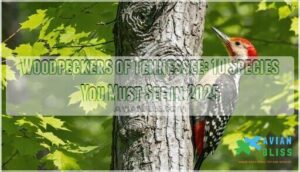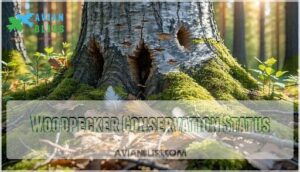This site is supported by our readers. We may earn a commission, at no cost to you, if you purchase through links.

These feathered carpenters inhabit everything from backyard oak trees to deep forest hollows, each species sporting unique markings and behaviors that make identification easier than you’d think.
The Red-headed Woodpecker’s crimson cap can’t be missed, while the Northern Flicker’s ground-foraging habits set it apart from its tree-dwelling cousins.
Tennessee’s diverse habitats support these remarkable birds through oak-hickory forests, pine plantations, and urban parks.
Understanding their preferred foods, nesting sites, and seasonal patterns reveals fascinating secrets about their survival strategies and how they thrive in different environments, making them a joy to study and observe.
Table Of Contents
- Key Takeaways
- Tennessee Woodpecker Species
- Woodpecker Physical Characteristics
- Woodpecker Behavior and Diet
- Woodpecker Conservation Status
- Woodpecker Viewing and Photography
- Frequently Asked Questions (FAQs)
- What is the most common woodpecker in Tennessee?
- What are the most common woodpeckers?
- Are northern flickers in Tennessee?
- What is the rarest type of woodpecker?
- What are common woodpecker sounds in Tennessee?
- How do woodpeckers impact local ecosystems?
- What are the best times to see woodpeckers?
- How do woodpeckers avoid head injury?
- What do baby woodpeckers eat and how are they fed?
- When do woodpeckers migrate in Tennessee?
- Conclusion
Key Takeaways
- You’ll find seven woodpecker species year-round in Tennessee, ranging from the tiny 6-inch Downy Woodpecker to the crow-sized 18-inch Pileated Woodpecker, with the Red-bellied being your most common encounter.
- You can identify Tennessee’s woodpeckers by their distinct features: Red-headed‘s crimson cap, Northern Flicker‘s ground-foraging habits and mustache marks, and Pileated‘s rectangular holes in mature forests.
- You’ll have the best success spotting woodpeckers during dawn and dusk hours in diverse habitats from backyard oak trees to deep forest hollows, with places like Great Smoky Mountains National Park and Cades Cove offering prime viewing opportunities.
- You’re witnessing specialized survival strategies when observing their behaviors – from drumming communication and territorial displays to their varied diets of insects, sap, nuts, and seeds that change with seasonal availability.
Tennessee Woodpecker Species
Tennessee’s woodpeckers include seven regular species and one rare species that call the state home throughout the year or during specific seasons.
You’ll find everything from the tiny Downy Woodpecker to the impressive crow-sized Pileated Woodpecker, with the Red-bellied Woodpecker being your most likely encounter in nearly any wooded area across the state.
Common Woodpecker Types
Five Tennessee woodpeckers dominate backyards and forests statewide.
You’ll spot the tiny Downy Woodpecker at feeders, while Red-bellied ID becomes easy with their zebra-striped backs and rusty bellies.
Pileated Habitat includes mature forests where these crow-sized giants excavate rectangular holes.
Northern Flicker Adaptations help them forage on ground for ants.
Sapsucker Migration brings Yellow-bellied species through Tennessee seasonally.
Alabama, however, hosts eight unique species.
Rare and Endangered Species
You’ll spot the Red-cockaded Woodpecker’s tragic story across Tennessee’s vanished pine forests.
This species once called Tennessee home but disappeared due to habitat loss, representing one of conservation’s greatest challenges.
Recovery efforts continue despite the species’ local extinction.
Tennessee, however, is still home to a variety of species, including the Hairy and Downy Woodpeckers.
- Red-cockaded Woodpecker: Tennessee’s lost species, locally extinct since habitat destruction
- Habitat Loss: 99% population decline from longleaf pine ecosystem destruction
- Conservation Strategies: Controlled burns and pine restoration programs ongoing
- Population Decline: Fewer than 10,000 individuals remain range-wide since 1973
- Recovery Efforts: Federal protection downgraded to threatened status in 2024
Woodpecker Distribution Patterns
Tennessee’s woodpecker species show distinct habitat preferences across elevation gradients and regional variations.
You’ll find common woodpeckers like Red-bellied scattered statewide, while Pileated favor mature forests.
Urban adaptation varies by species—some thrive in parks, others need wild spaces.
Seasonal migration brings northern Red-headed visitors to boost winter populations.
This Tennessee birds diversity reflects local wildlife patterns shaped by geography.
These birds are often found as monogamous pairs that stay together year-round, demonstrating monogamous behavior and local wildlife characteristics.
Woodpecker Physical Characteristics
You’ll need to recognize Tennessee’s woodpeckers by their distinct physical features, from the tiny 6-inch Downy to the crow-sized Pileated with its striking red crest.
Each species displays unique size variations, plumage patterns, and specialized beak shapes perfectly adapted for their specific feeding methods and forest habitats.
Size and Plumage Variations
You’ll discover remarkable size variations among Tennessee’s common woodpeckers, from tiny Downy Woodpeckers measuring just six inches to massive Pileated Woodpeckers reaching eighteen inches.
Size dimorphism between males and females isn’t dramatic, though males typically display brighter plumage coloration.
Regional variations exist subtly across the state, while juvenile plumage differs markedly from adults.
Molting patterns help identify species during seasonal changes when woodpecker identification becomes more challenging, and understanding these patterns is crucial for recognizing the regional variations.
Identifying Features and Markings
Looking at woodpecker identification features, you’ll notice distinct plumage coloration helps separate species.
Red-bellied and Red-headed woodpeckers show striking red markings, while Downy and Hairy woodpeckers display black-and-white patterns.
Male woodpeckers typically have red patches that females lack.
Crest variations distinguish Pileated from other backyard woodpeckers, and facial patterns create unique "fingerprints" – Northern Flickers sport distinctive mustache marks.
Juvenile markings often differ from adults, making woodpecker identification challenging for beginners, due to the variety of characteristics such as distinct markings.
Beak Shape and Function
Beyond those distinctive markings, you’ll notice how each species’ beak tells a fascinating story of evolutionary adaptation.
Woodpeckers’ beak morphology reflects millions of years of evolutionary pressures, creating specialized drilling mechanics for different food sources.
The Pileated Woodpecker’s chisel-like beak excels at drilling through bark, while the Yellow-bellied Sapsucker‘s narrower design enables precise sap extraction.
These beak adaptations directly influence woodpecker behavior, diet preferences, and habitat selection across Tennessee’s diverse ecosystems.
Woodpecker Behavior and Diet
When you observe woodpeckers in Tennessee, you’ll notice their feeding behaviors change dramatically with the seasons and available food sources.
These birds communicate through distinctive drumming patterns and calls that serve both territorial and mating purposes, utilizing drumming to convey their messages.
Feeding Habits and Food Sources
Understanding what Tennessee’s woodpeckers eat helps you spot them in action.
These birds showcase diverse Foraging Strategies that reflect their specialized woodpecker diet needs across different woodpecker habitat types.
Woodpecker feeding patterns you’ll observe:
- Insect Consumption – Most species hunt beetle larvae, ants, and termites beneath bark using their strong beaks
- Sap Feeding – Yellow-bellied Sapsuckers drill neat rows of holes to access tree sap and trapped insects
- Nut Preference – Red-headed Woodpeckers cache acorns and nuts in bark crevices for winter storage
- Seed Predation – Many species eat sunflower seeds, suet, and berries, making feeders effective for woodpecker attracting
Mating and Breeding Behaviors
During spring’s mating season, woodpeckers perform elaborate courtship rituals including drumming displays and aerial chases.
Males excavate nest cavities in dead trees, demonstrating their fitness to potential mates.
After pairing, females lay 3-5 white eggs with a 12-day incubation period.
Both parents share parental care duties, feeding chicks regurgitated insects for 24-28 days until chick development completes.
Social Interactions and Communication
Woodpeckers communicate through vocalizations and drumming signals that serve multiple purposes.
You’ll hear territorial calls echoing through forests as males defend their areas from intruders.
These woodpecker sounds also attract mates during breeding season.
Some species practice cooperative breeding, where family groups work together.
Territory defense involves aggressive displays and persistent drumming patterns that establish boundaries and warn competitors away.
Woodpeckers also use non-vocal communication like posturing to signal aggression.
Woodpecker Conservation Status
You’ll find Tennessee’s woodpeckers face serious conservation challenges that threaten their long-term survival in the state.
Understanding these threats and ongoing protection efforts helps you appreciate why preserving woodpecker habitat is essential for maintaining healthy forest ecosystems.
Threats to Woodpecker Populations
Tennessee’s woodpeckers face mounting challenges that threaten their survival.
Habitat Loss from logging and development reduces nesting sites, while invasive Starling Competition limits cavity availability.
Fire Suppression eliminates natural snags these birds need.
Climate Change disrupts breeding cycles and food sources, and Insecticide Use depletes their insect prey.
These combined pressures require immediate woodpecker conservation action.
Habitat Destruction and Fragmentation
You’ll find that habitat loss hits Tennessee’s woodpeckers particularly hard.
Forest loss and urban sprawl destroy critical nesting sites, while fire suppression eliminates natural pine ecosystems.
Snag removal reduces available cavities, and ecosystem impacts from fragmentation limit food sources.
These woodpecker conservation challenges directly affect woodpecker behavior patterns and survival rates across all species.
Conservation Efforts and Initiatives
Multiple conservation programs protect Tennessee’s woodpeckers through targeted habitat restoration and snag preservation efforts.
Fire management practices maintain healthy forest ecosystems while reducing nest competition from invasive species.
Public awareness campaigns educate communities about woodpecker facts and behavior, promoting woodpecker prevention methods that balance human needs with wildlife protection for sustainable coexistence.
Some species, like the acorn woodpecker’s diet, also includes insects and tree sap, highlighting the importance of wildlife protection.
Woodpecker Viewing and Photography
You’ll find Tennessee’s woodpeckers in various habitats, from dense forests to suburban parks, making observation accessible for both beginners and experienced birders.
Success in photographing these dynamic birds requires understanding their feeding patterns, preferred perches, and the subtle body language that signals their next move.
Best Locations for Woodpecker Viewing
Prime locations offer diverse habitats supporting multiple woodpecker species throughout Tennessee’s State Parks and Wildlife Refuges.
You’ll discover exceptional bird watching opportunities along established Birding Trails and surprising Urban Hotspots during Seasonal Migrations.
- Great Smoky Mountains National Park – Mature forests with abundant dead trees attract Pileated Woodpeckers
- Cades Cove – Open woodlands provide excellent viewing for Red-bellied and Downy species
- Reelfoot Lake State Park – Wetland forests support diverse woodpecker populations year-round
- Hatchie National Wildlife Refuge – Mixed habitats offer prime woodpecker facts and viewing experiences.
Capturing these moments requires high-quality camera equipment.
Photography Techniques and Tips
Capturing sharp woodpecker images requires fast shutter speeds (1/500s+) to freeze rapid movements.
Use continuous autofocus for active birds and spot metering for proper exposure. Position yourself at eye level when possible, maintaining respectful distances to avoid disturbing their natural behaviors.
Early morning offers ideal lighting conditions and increased woodpecker activity. Practice ethical photography by never approaching nests or using playback calls excessively during breeding seasons.
Utilizing golden hour lighting can substantially enhance the details in your images.
Woodpecker Behavior and Body Language
Perfect timing comes after mastering camera techniques – reading woodpecker body language transforms ordinary shots into compelling wildlife stories.
Capturing woodpecker behavior reveals the secret stories behind every wing flap and head tilt.
You’ll recognize aggressive postures, mating rituals, and feeding behaviors that reveal each bird’s personality.
Drumming Communication serves multiple purposes beyond simple noise-making.
Capturing these moments often requires specialized woodpecker photography equipment.
- Territory Defense: Males spread wings wide and raise crests when confronting rivals, creating dramatic woodpecker images
- Courtship Displays: Pairs perform synchronized head-bobbing dances before selecting nesting sites together
- Social Hierarchy: Dominant birds maintain upright postures while subordinates crouch low during feeding encounters
Frequently Asked Questions (FAQs)
What is the most common woodpecker in Tennessee?
Birds of a feather flock together, and you’ll find the Red-bellied Woodpecker is Tennessee’s most common species.
It’s found in nearly all wooded habitats throughout the state, making it your most likely woodpecker encounter.
What are the most common woodpeckers?
You’ll find Red-bellied Woodpeckers are Tennessee’s most common species, thriving in nearly all wooded habitats. Downy and Hairy Woodpeckers are also widespread, while Pileated Woodpeckers represent the largest species statewide.
Are northern flickers in Tennessee?
Ever wonder which woodpeckers drum through Tennessee’s forests year-round?
Yes, Northern Flickers are among the seven woodpecker species regularly found in Tennessee.
You’ll spot these ground-foraging woodpeckers in deciduous and mixed forests throughout the state.
What is the rarest type of woodpecker?
You’ll find the Red-cockaded Woodpecker holds the title as North America’s rarest species.
This critically endangered bird has vanished from most territories, surviving only in scattered pine forests across the Southeast.
What are common woodpecker sounds in Tennessee?
Strangely enough, you’ll hear these common sounds right outside your door.
Rhythmic drumming broadcasts territorial and mating messages, while high piping calls and "wuk-wuk" sounds indicate boundaries from Tennessee’s seven resident species.
How do woodpeckers impact local ecosystems?
You’ll discover woodpeckers serve as ecosystem engineers, creating cavities that over 40 bird, mammal, and reptile species use for nesting. They control insect populations and spread seeds through foraging activities.
What are the best times to see woodpeckers?
Like early birds catching worms, you’ll spot woodpeckers best during dawn and dusk when they’re most active.
Early morning hours offer peak activity as they forage for insects and communicate through drumming on trees.
How do woodpeckers avoid head injury?
You’re tackled with complex forces while pecking, but your strong skull and specialized neck muscles handle 1,000 times gravity’s force.
Spongy bone plates in your frontal skull absorb impacts, protecting your brain from serious injury.
What do baby woodpeckers eat and how are they fed?
Roughly 70% of baby woodpeckers’ diets consists of protein-rich insects.
You’ll see parents regurgitate insects like beetle larvae and grubs to their nestlings.
Both parents feed these youngsters insects, seeds, berries, and other typical woodpecker foods.
When do woodpeckers migrate in Tennessee?
You’ll find that most Tennessee woodpeckers don’t migrate at all – they’re year-round residents. Only the Yellow-bellied Sapsucker migrates, arriving in fall and departing by spring for northern breeding grounds.
Conclusion
Ready to become Tennessee’s next woodpecker expert?
These remarkable birds offer endless opportunities for observation and discovery.
From your backyard feeder to remote forest trails, woodpeckers of Tennessee provide year-round entertainment for nature enthusiasts.
You’ll find success by learning their calls, understanding their preferred habitats, and respecting their space.
Whether you’re photographing a Pileated Woodpecker’s powerful strikes or watching Downies at your suet feeder, each encounter deepens your appreciation for these specialized forest dwellers.
- https://www.tn.gov/twra/law-enforcement/wildlife-damage-control/woodpecker-problems.html
- https://www.nature.org/en-us/get-involved/how-to-help/animals-we-protect/red-cockaded-woodpecker/
- https://www.tnwatchablewildlife.org/mobiledetails.cfm?displayhabitat=&sort=backyard&typename=TENNESSEE%27S&commonname=Red-headed+Woodpecker
- https://www.southernenvironment.org/press-release/red-cockaded-woodpecker-loses-endangered-species-status/
- https://avibirds.com/woodpeckers-in-tennessee/












